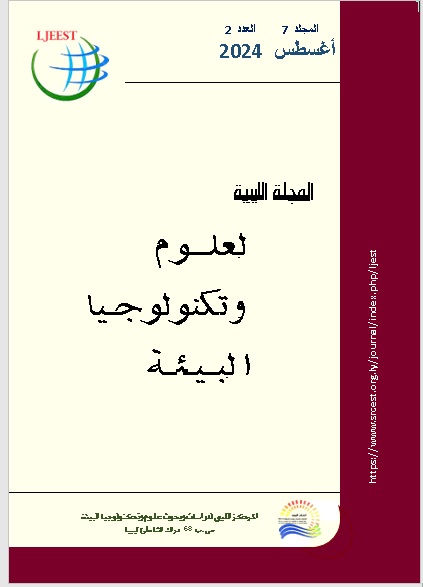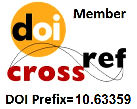المخاطر الإشعاعية للاستهلاك اليومي للقهوة: تحليل تراكيز النويدات المشعة في حبوب البن المستوردة (دراسة حالة: ليبيا)
DOI:
https://doi.org/10.63359/g4p9jq92الكلمات المفتاحية:
مخاطر الاشعاع، استهلاك البن، العناصر المشعة، الجرعة المؤثرةالملخص
هدفت هذه الدراسة إلى تقييم المخاطر الإشعاعية المحتملة الناتجة عن الاستهلاك اليومي للقهوة، وذلك من خلال تحليل مستويات الملوثات الإشعاعية الطبيعية والاصطناعية في حبوب البن المستوردة إلى ليبيا. ونظراً لكون القهوة من أكثر المشروبات استهلاكاً على مستوى العالم، فإن هذه الورقة تسلط الضوء على قضية غالباً ما تُهمل في دراسات السلامة الغذائية، وهي التلوث الإشعاعي في المنتجات الغذائية. تم جمع عينات من حبوب البن المحمصة من نوعي "أرابيكا" و"روبوستا" والمستوردة من أربع دول رئيسية في إنتاج القهوة: الهند، البرازيل، كولومبيا، وأثيوبيا. وقد تم تحليل هذه العينات باستخدام منظومة مطيافية جاما عالية الدقة والمزودة بكاشف الجرمانيوم عالي النقاوة. (HPGe) أظهرت نتائج التحليل عدم وجود نشاط إشعاعي ناتج عن نويدات مشعة صناعية في المقابل، تم الكشف عن وجود تراكيز قابلة للقياس من النويدات المشعة الطبيعية: البوتاسيوم-40 (K-40)، والراديوم-226 (Ra-226)، والراديوم-228 (Ra228) . وقد تجاوز تركيز K-40 الحد المرجعي الذي أوصت به اللجنة العلمية التابعة للأمم المتحدة المعنية بآثار الإشعاع الذري (UNSCEAR)، بينما ظلت تراكيز Ra-226 وRa-228 ضمن المستويات الآمنة. تراوحت الجرعة الفعالة السنوية المقدّرة الناتجة عن استهلاك القهوة لدى البالغين بين 17.68 ملي سيفرت/سنة و92.57 ملي سيفرت/سنة. وقد سجلت القهوة الكولومبية أقل قيمة للجرعة الفعالة، في حين كانت القهوة البرازيلية الأعلى من حيث الجرعة المقدّرة. ومع ذلك، تبيّن أن جميع القيم المسجلة للجرعة الفعالة السنوية كانت دون المتوسط العالمي للتعرض الإشعاعي الداخلي. تشير النتائج إلى أن مستويات النشاط الإشعاعي في حبوب القهوة التي تم تحليلها لا تمثل تهديداً صحياً كبيراً للمستهلكين في الوقت الراهن. ومع ذلك، فإن المراقبة المنتظمة والتنظيم الفعال يظلان ضروريين لضمان استمرار سلامة المنتجات الغذائية، والحفاظ على صحة وسلامة المستهلك على المدى الطويل.
المراجع
Abodunrin, O., Olaoye, M. A., & Okuwobi, B. A. (2024). Long-lived GammaEmitting Radionuclides in Commonly Consumed Imported Coffee Brands in Lagos and the Total Committed Effective Dose using a High Purity Germanium Detector. London Journal of Physics, 1(1). https://doi.org/10.69710/ljp.v1i1.10343
Ali, J. M., Hasan, H. M. A., & Hasan, J. M (2022). Evaluation of Radioactive Elements in some Vegetables Samples Collected from Different Regions around Al-Guba City-Libya. https://ljbs.omu.edu.ly
AL-abrdi, A. M (2023). Measurements of natural radioactivity and evaluation of radiation hazard indices in Barley Samples in Libya Markets. Libyan Journal of Basic Sciences (LJBS): 20, No: 2, P: 51-64 https://ljbs.omu.edu.ly/eISSN
AL-abrdi, A. M., Hazawi, A. A., Alsaadi, S. D., & Abdullah, R. H. (2023). Estimation of Annual Gonadal Dose Equivalent in Some Livestock Food inLibyanMarkets.https://doi.org/10.54172/mjsc.v38i2.1207
Awudu, A., Faanu, A., Darko, E., Emi-Reynolds, G., Adukpo, O., Kpeglo, D., ... & Agyeman, B. (2012). Preliminary studies on 226 Ra, 228 Ra, 228 Th and 40 K concentrations in foodstuffs consumed by inhabitants of Accra metropolitan area, Ghana. Journal of Radioanalytical and Nuclear Chemistry, 291(3), 635-641. https://doi.org/10.1007/s10967-011-1444-9
Elmasri, K., & Algretli, A. (2023). Measurement of Natural Radionuclides Concentration in Libyan Food Spices Samples. Alostath, (24). https://www.uotpa.org.ly/alostath/index.php/alostath/article/view/314
Geras' kin, S., Evseeva, T., & Oudalova, A. (2013). Effects of long-term chronic exposure to radionuclides in plant populations. Journal of Environmental Radioactivity, 121, 22-32 https://doi.org/10.1016/j.jenvrad.2012.03.007
Helgi Analytics, (2023.). Coffee consumption per capita of Libya. Helgi Library. https://www.helgilibrary.com/indicators/coffee-consumption-per-capita/libya/
ICRP, 2012. Compendium of Dose Coefficients Based on ICRP Publication 60, vol. 119 ICRP Publication Ann. ICRP 41 (Suppl.). Available at. https://www.icrp.org/docs/P%20119%20JAICRP%2041(s)%20Compendium%20of%20Dose%20Coefficients%20based%20on%20ICRP%20Publication%2060. pdf
Jibiri NN, Isinkaye MO, Bello IA, Olaniyi PG (2016). Dose assessments from the measured radioactivity in soil, rock, clay, sediment and food crop samples of an elevated radiation area in south-western Nigeria. Environ. Earth Sci. 75:107.
Kanda, J. (2013). Continuing 137 Cs release to the sea from the Fukushima Dai-ichi Nuclear Power Plant through 2012. Biogeosciences, 10(9), 6107-6113. https://doi.org/10.5194/bg-10-6107-2013, 2013.
Khandaker, M. U., Zainuddin, N. K., Bradley, D. A., Faruque, M. R. I., Almasoud, F. I., Sayyed, M. I., ... & Jojo, P. J. (2020). Radiation dose to Malaysian populace via the consumption of roasted ground and instant coffee. Radiation Physics and Chemistry, 173, 108886. https://doi.org/10.1016/j.radphyschem.2020.108886
Ramli, A. T., Apriantoro, N. H., & Wagiran, H. (2009). Assessment of radiation dose rates in the high terrestrial gamma radiation area of Selama District, Perak, Malaysia. Applied Physics Research, 1(2), 45.
.Roselli, C., Desideri, D., Rongoni, A., Saetta, D., & Feduzi, L. (2013). Radioactivity in coffee. Journal of Radioanalytical and Nuclear Chemistry, 295, 1813-1818.
Sangbok, L., Choi, D., Park, J., Lee, S., Choi, K., Seunggeon, A., ... & Jang, Y. (2021). Analysis of Gamma Radioactivity Concentration of Coffee and Investigation of Harmfulness using High Purity Germanium Detector. In Transactions of the Korean Nuclear Society Virtual Spring Meeting May (pp. 13-14).
Kanda, J. (2013). Continuing 137 Cs release to the sea from the Fukushima Dai-ichi Nuclear Power Plant through 2012. Biogeosciences, 10(9), 6107-6113. https://doi.org/10.5194/bg-10-6107-2013, 2013.
Khandaker, M. U., Zainuddin, N. K., Bradley, D. A., Faruque, M. R. I., Almasoud, F. I., Sayyed, M. I., ... & Jojo, P. J. (2020). Radiation dose to Malaysian populace via the consumption of roasted ground and instant coffee. Radiation Physics and Chemistry, 173,108886.https://doi.org/10.1016/j.radphyschem.2020.108886
Ramli, A. T., Apriantoro, N. H., & Wagiran, H. (2009). Assessment of radiation dose rates in the high terrestrial gamma radiation area of Selama District, Perak, Malaysia. Applied Physics Research, 1(2), 45.
.Roselli, C., Desideri, D., Rongoni, A., Saetta, D., & Feduzi, L. (2013). Radioactivity in coffee. Journal of Radioanalytical and Nuclear Chemistry, 295, 1813-1818.
Sangbok, L., Choi, D., Park, J., Lee, S., Choi, K., Seunggeon, A., ... & Jang, Y. (2021). Analysis of Gamma Radioactivity Concentration of Coffee and Investigation of Harmfulness using High Purity Germanium Detector. In Transactions of the Korean Nuclear Society Virtual Spring Meeting May (pp. 1314). https://doi.org/10.21608/aunj.2024.263847.1073
Sarap, N. B., Janković, M. M., Todorović, D. J., Nikolić, J. D., & Kovačević, M. S. (2014). Environmental radioactivity in southern Serbia at locations where depleted uranium was used. Archives of Industrial Hygiene and Toxicology, 65(2), 189-197. Doi 10.2478/10004-1254-65-2014-2427
United Nations Scientific Committee on the Effects of Atomic Radiation. (2000). Sources and effects of ionizing radiation: UNSCEAR 2000 Report to the General Assembly, with scientific annexes. United Nations.
United Nations Scientific Committee on the Effects of Atomic Radiation. (2010). Sources and effects of ionizing radiation, united nations scientific committee on the effects of atomic radiation (UNSCEAR) 2008 report, volume I: Report to the
التنزيلات
منشور
إصدار
القسم
الرخصة
الحقوق الفكرية (c) 2025 المجلة الليبية لعلوم وتكنولوجيا البيئة (م ل ع ت ب)

هذا العمل مرخص بموجب Creative Commons Attribution-NonCommercial 4.0 International License.















